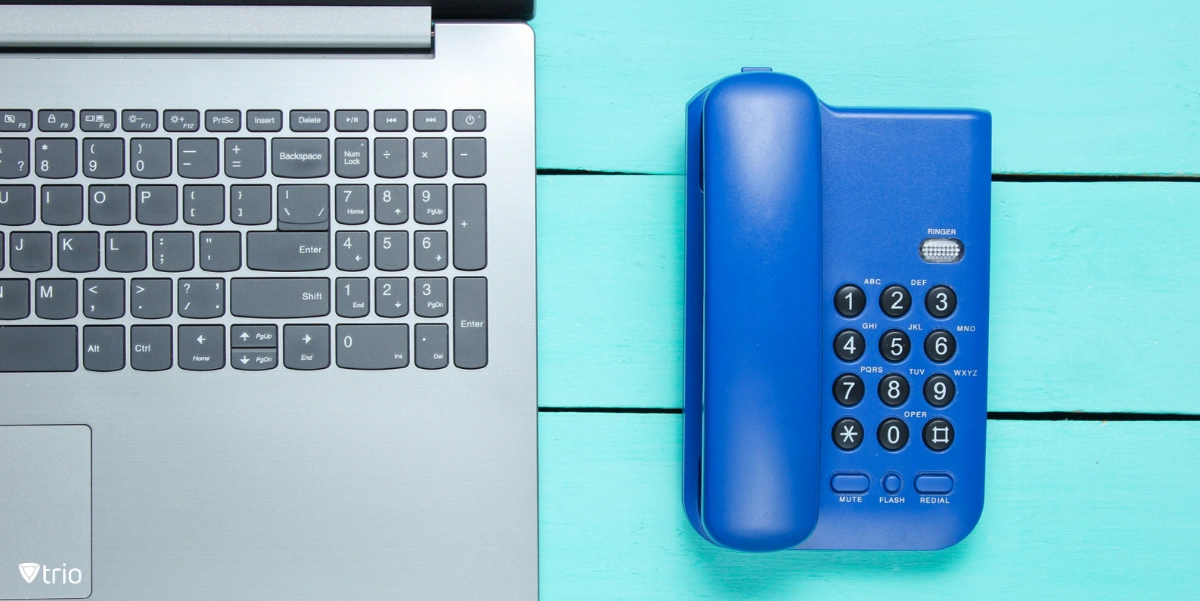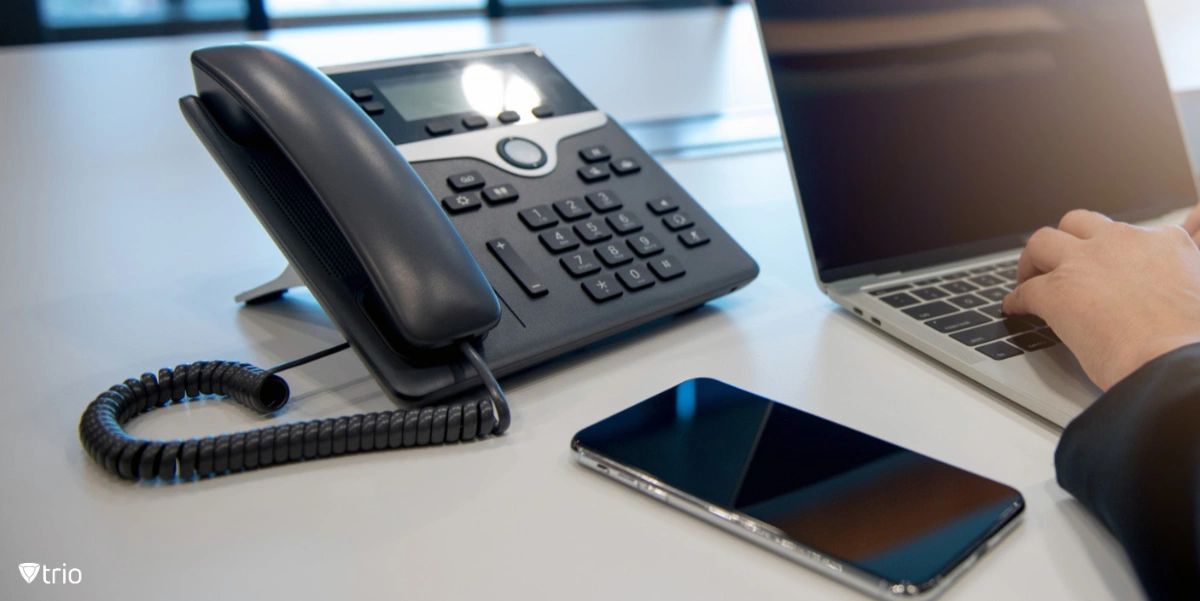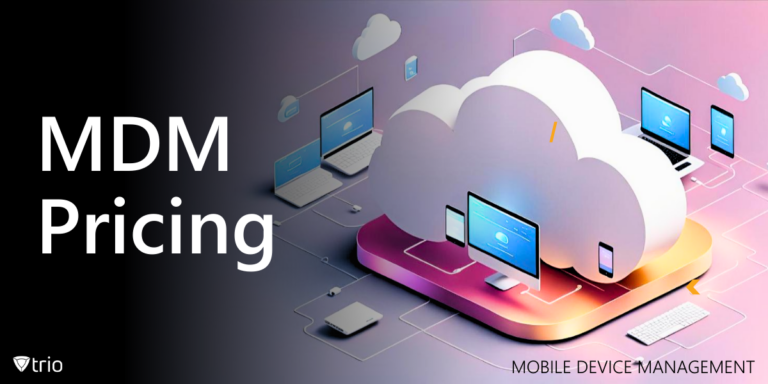In the realm of business communication, there exist two prominent players: Softphone vs Deskphone. Both of them have their unique strengths and applications, and choosing between them often boils down to the specific requirements of your business. In this comprehensive guide, we will dissect each of these tools, laying bare their features, benefits, and potential drawbacks. Moreover, we will introduce the Trio MDM solution and explain how it can magnify the benefits of both these options for IT administrators and businesses.
An Overview of Softphones and Deskphones
Deskphones have evolved from traditional telephony to advanced VoIP devices, while softphones have emerged as versatile applications for various digital devices. Below, we delve into the technicalities and practical uses of these two types of phones to understand their unique features and how they fit into modern communication systems.
What is a Deskphone?
A deskphone, often referred to as a hardphone, is a VoIP-enabled telephone that transmits voice signals in digital packets using the internet. It replaces the legacy phone lines with Ethernet or fiber-optic cables. Deskphones resemble traditional phones in their physical form but are far more advanced in their capabilities.
What is a Softphone?
On the other hand, a softphone is a software application that can be installed on various devices like smartphones, tablets, and PCs. It connects these devices to a VoIP network, allowing them to make and manage phone calls over the Internet. Unlike a deskphone, a softphone does not have a physical presence.

Decoding the Features of Softphones and Deskphones
Understanding the features of softphones and deskphones is crucial for businesses and individuals alike. This section aims to dissect the array of features offered by both types of phones, highlighting how each caters to different communication needs in a professional setting. Whether it’s the hardware reliability of deskphones or the versatile functionality of softphones, we’ll explore what sets them apart and how they can be leveraged effectively.
Key Features of a Deskphone
Deskphones come equipped with several features that make them a reliable choice for businesses. They offer superior voice quality, as they are connected to the web through Ethernet cables. Moreover, they are easy to use, with their functionality mimicking traditional landline phones. This means that employees require no prior training to operate them. Deskphones provide dedicated hardware for communication, ensuring uninterrupted service.
Key Features of a Softphone
Softphones, on the other hand, offer a broader range of features. Besides making voice calls, they also support video calls, instant messaging, and voicemail management. Since they operate on software, they can easily integrate with other third-party applications and services, such as CRM systems. Softphones also allow users to control their presence and view other active users, which can boost productivity in a business environment.
The Case for Deskphone in a Traditional Office Setting
Deskphones have been the communication staple in traditional office spaces for years. Their standalone nature, coupled with their ease of use, makes them an attractive choice for businesses with a fixed workstation model. Deskphones offer a clear, uninterrupted call quality thanks to their hardwired internet connection. This makes them the preferred choice for businesses where high sound quality is a top priority.
Moreover, deskphones are also a cost-effective solution in the long run, particularly for businesses with existing landline setups. By connecting the existing landlines to a VoIP gateway, companies can leverage their old equipment while transitioning to a VoIP network. This leads to significant cost savings and ensures a smooth transition.

The Benefits of Softphone for a Remote Workforce
Softphones, in contrast, are incredibly beneficial for businesses that employ a remote workforce. They equip firms with the flexibility and mobility required to run remote services without compromising on the quality of communication.
Being cloud-based, softphones can be accessed from any device, anywhere, as long as there is a stable internet connection. This makes them an excellent tool for telecommuting employees, who can make and manage calls on their personal devices while their business numbers are displayed.
Softphones are also cost-effective as they eliminate the need for physical phone equipment. This results in significant cost savings for businesses, especially startups or businesses looking to reduce their communication costs.
The Trio MDM Solution: A Game Changer for Softphones and Deskphones
The Trio MDM solution is a powerful tool that can amplify the benefits of both softphones and deskphones. It provides businesses with a unified platform to manage and secure their devices, applications, and content.
The Trio MDM solution allows IT administrators to easily manage softphones and deskphones on a single platform. They can enforce security policies, track device usage, and even remotely lock or wipe devices in case of loss or theft. This not only enhances the security of business communication but also simplifies device management for administrators.
Moreover, the Trio MDM solution can integrate with various third-party applications, providing businesses with a comprehensive communication solution. Whether it’s CRM integration for softphones or VoIP gateway for deskphones, the Trio MDM solution can handle it all.
If you’re looking for a simple and scalable MDM solution for your organization, we recommend you try out Trio’s free demo.
Softphone vs Deskphone: The Final Verdict
Choosing between a softphone and a deskphone ultimately depends on the specific needs of your business. If your workforce is primarily remote and you are looking for a flexible and cost-effective solution, a softphone would be an optimal choice. On the other hand, if your business operates in a traditional office setting and prioritizes high sound quality, a deskphone would serve you best.
See Trio in Action: Get Your Free Trial Now!
However, these are not mutually exclusive choices. Many businesses adopt a hybrid approach, using both softphones and deskphones to cater to different needs within the organization. By understanding the features, benefits, and potential drawbacks of both these tools, you can make an informed decision that aligns with your business objectives. And with the Trio MDM solution, managing these diverse communication tools becomes a breeze.
In conclusion, both softphones and deskphones have a place in the modern business communication landscape. The choice between them is not a matter of superiority but of suitability. Whether you choose a softphone, a deskphone, or a combination of both, the key is to select the tool that best fits your business needs and enhances your communication capabilities.




